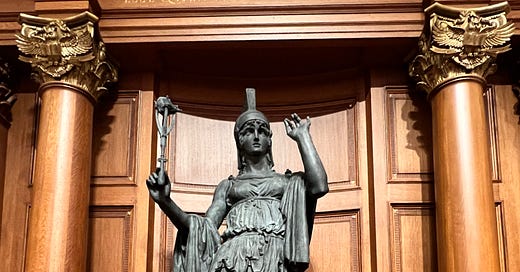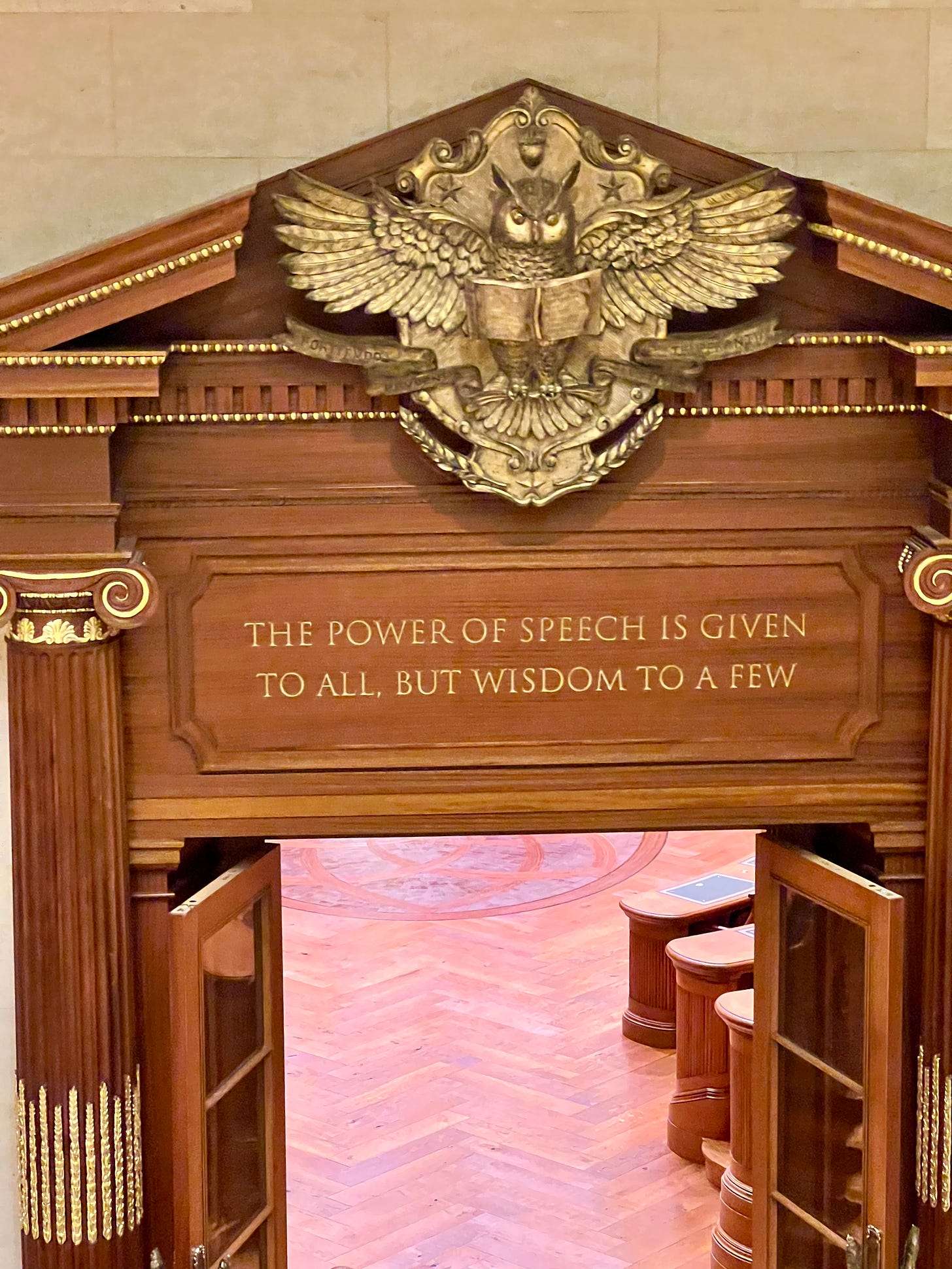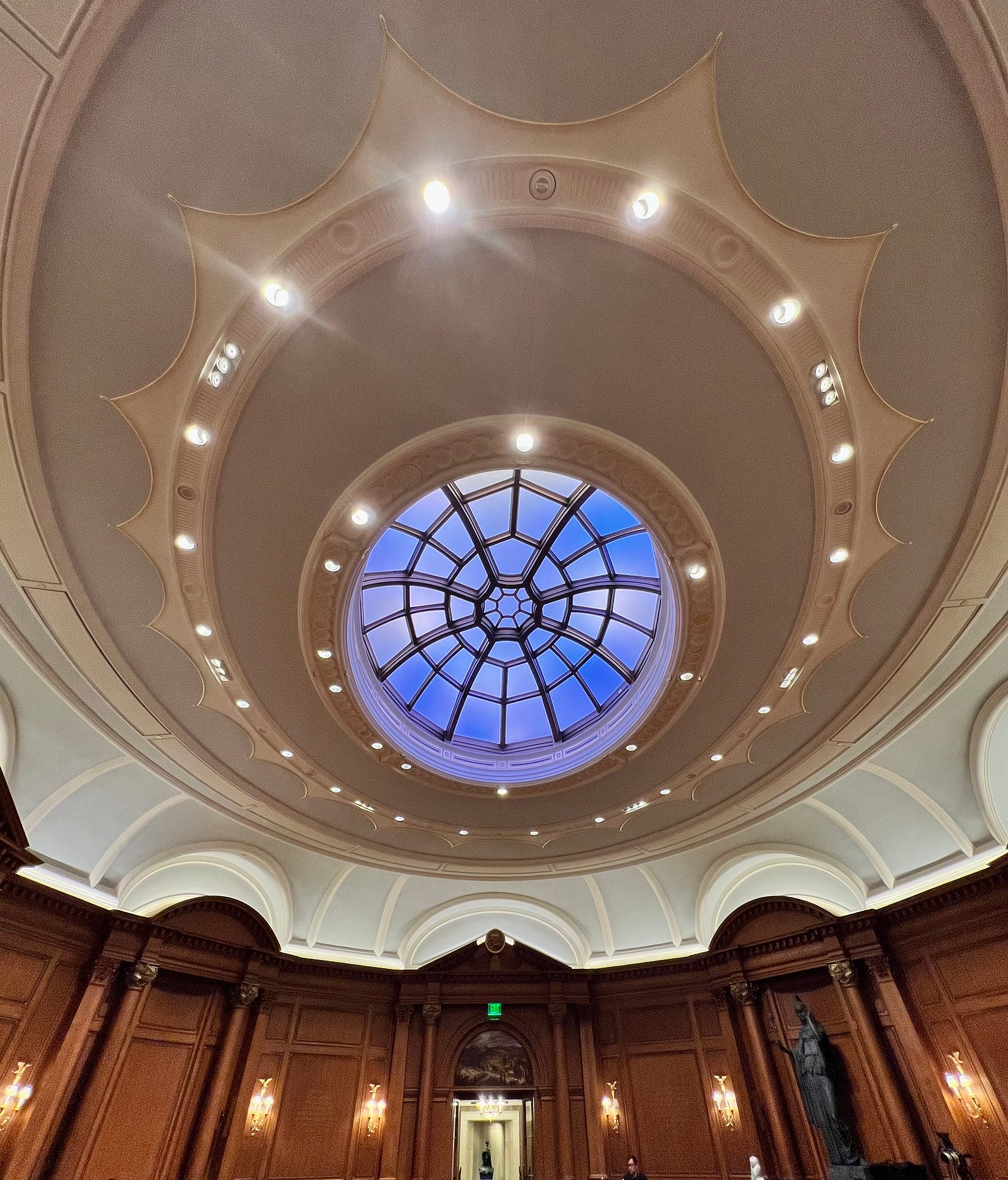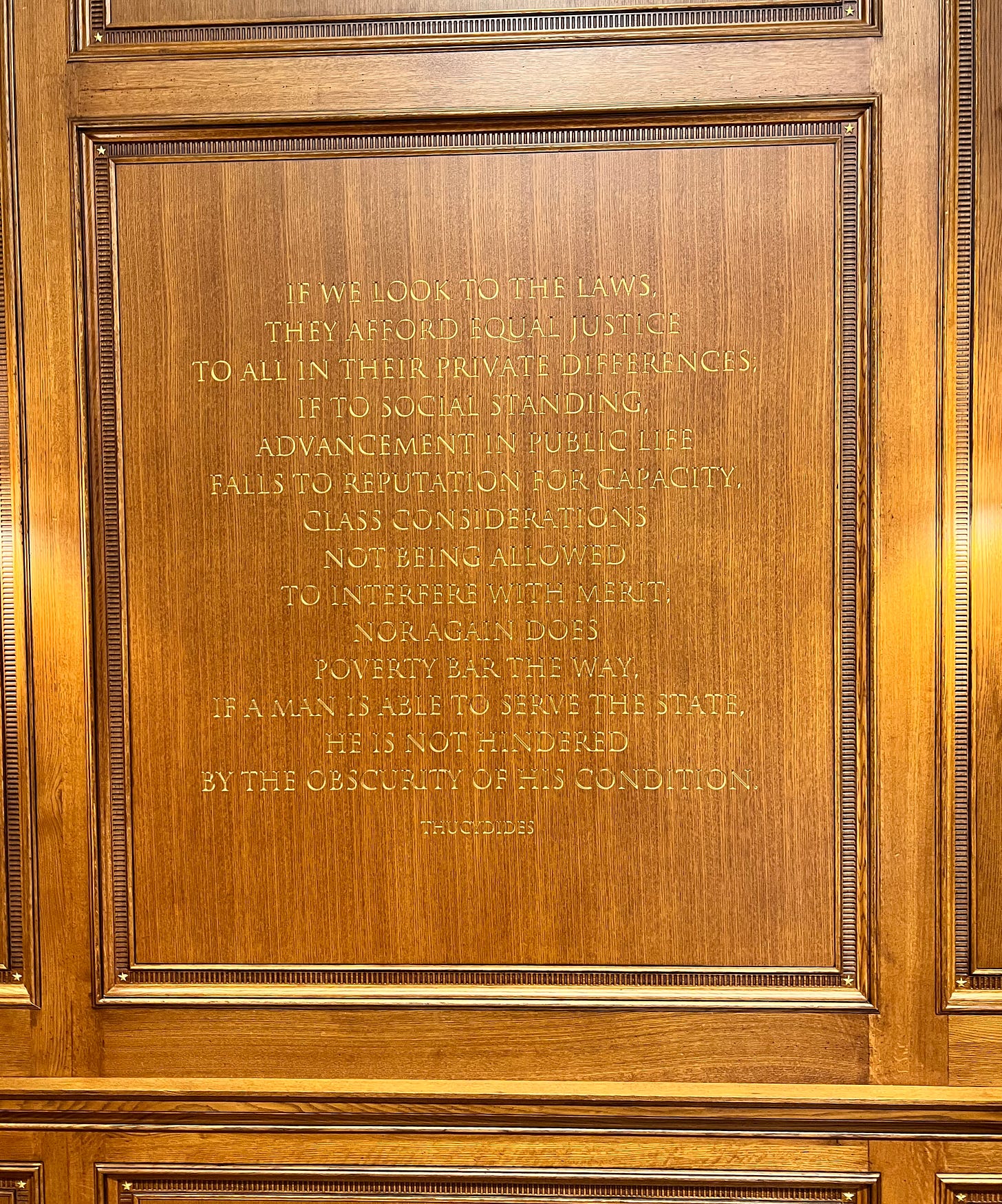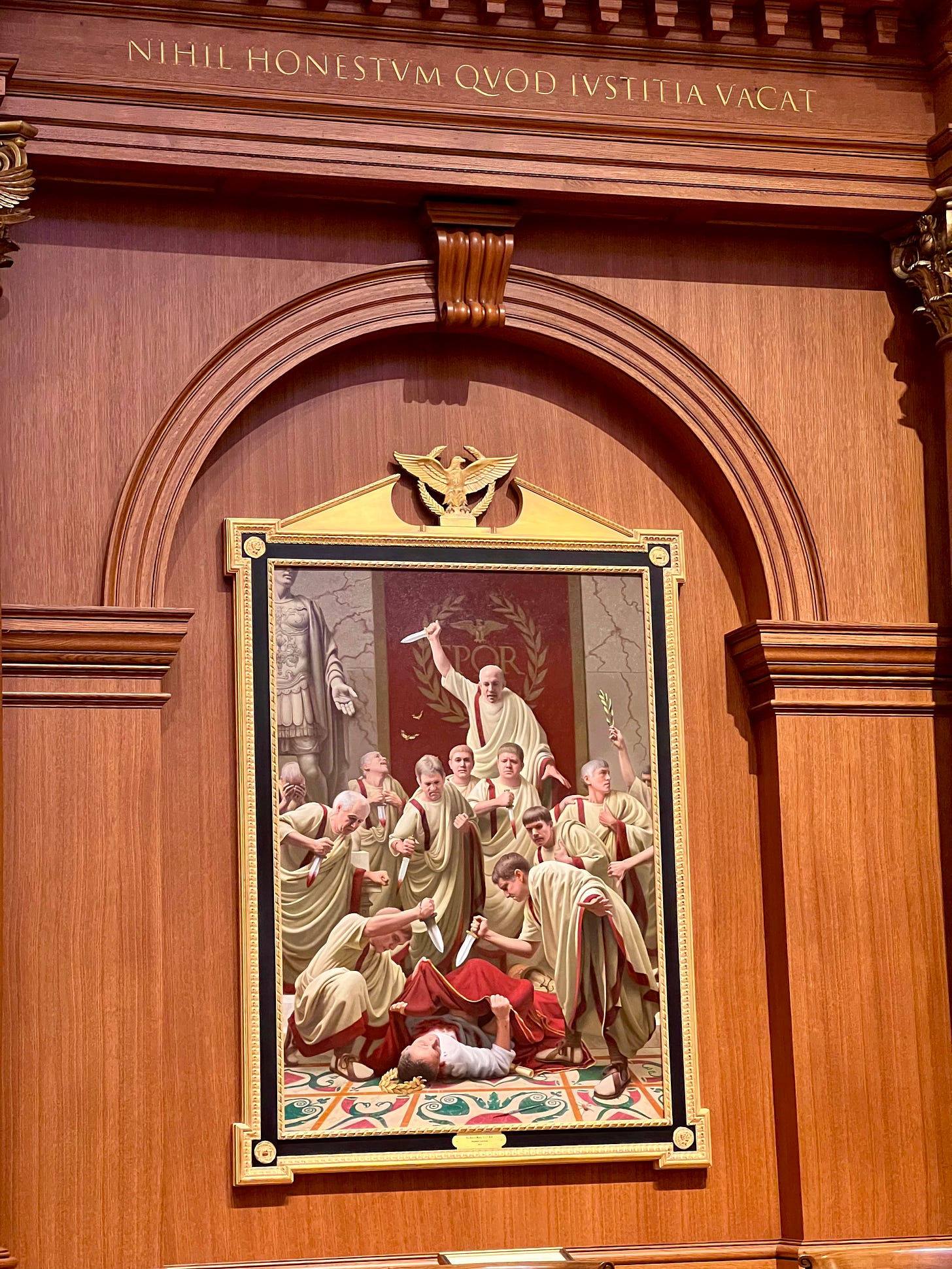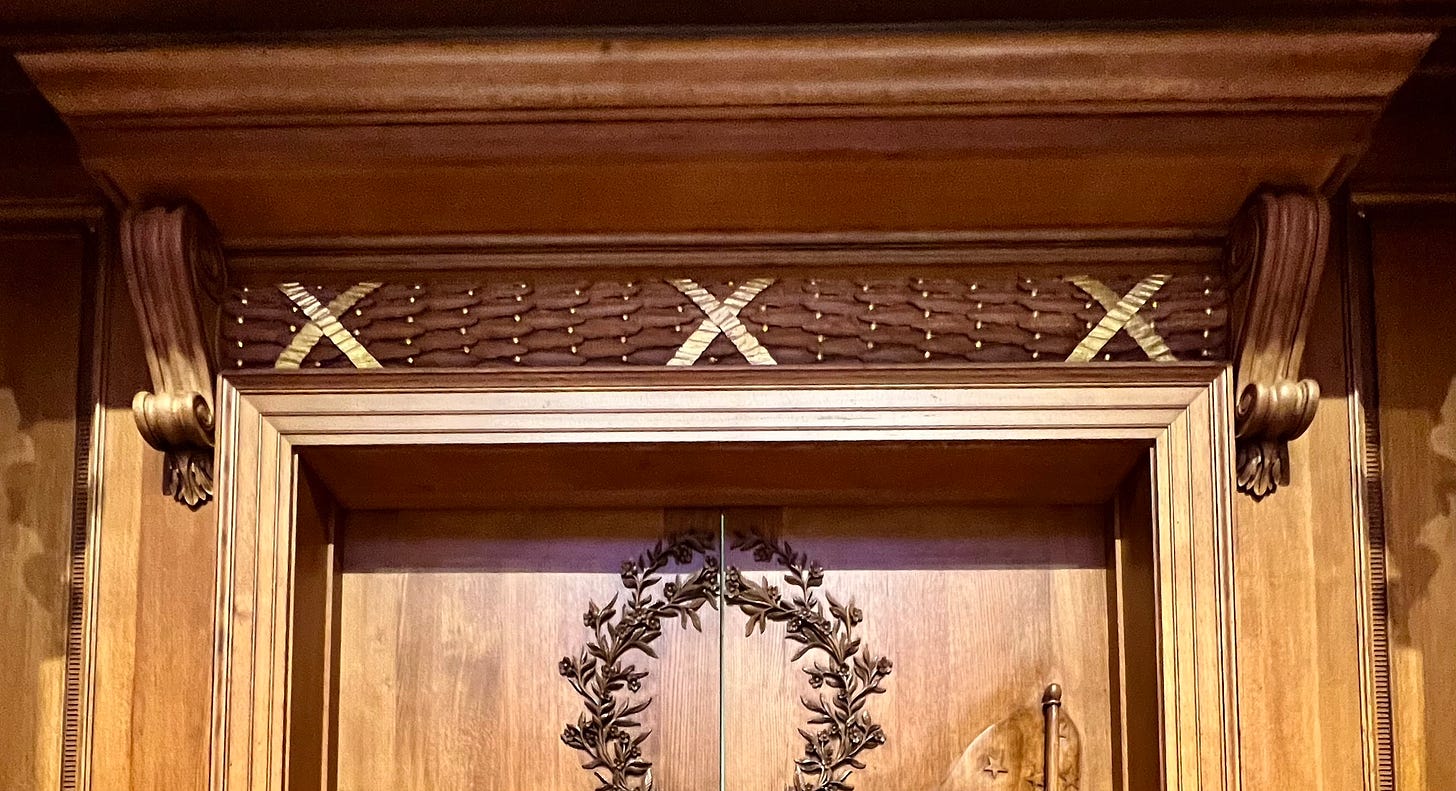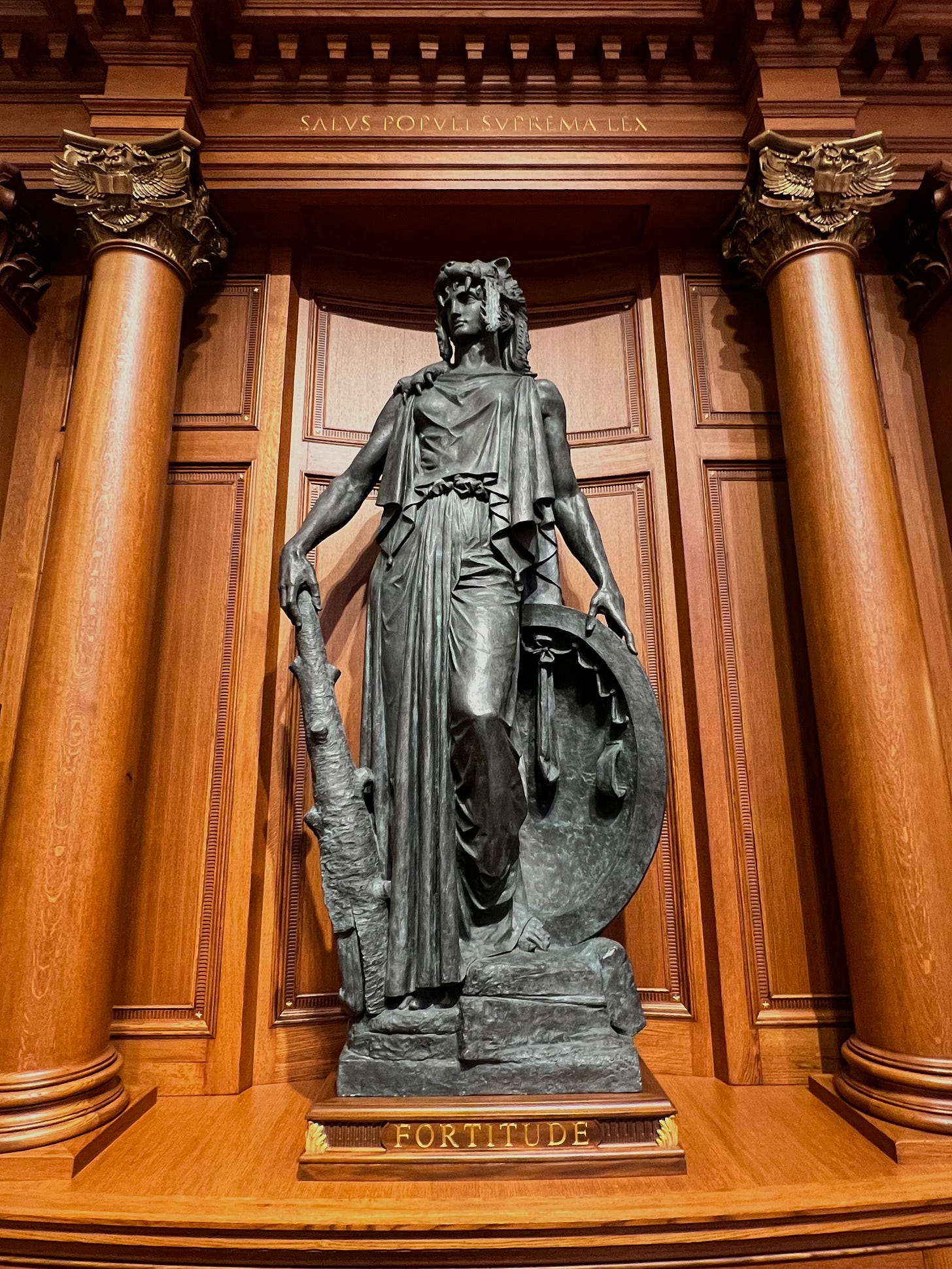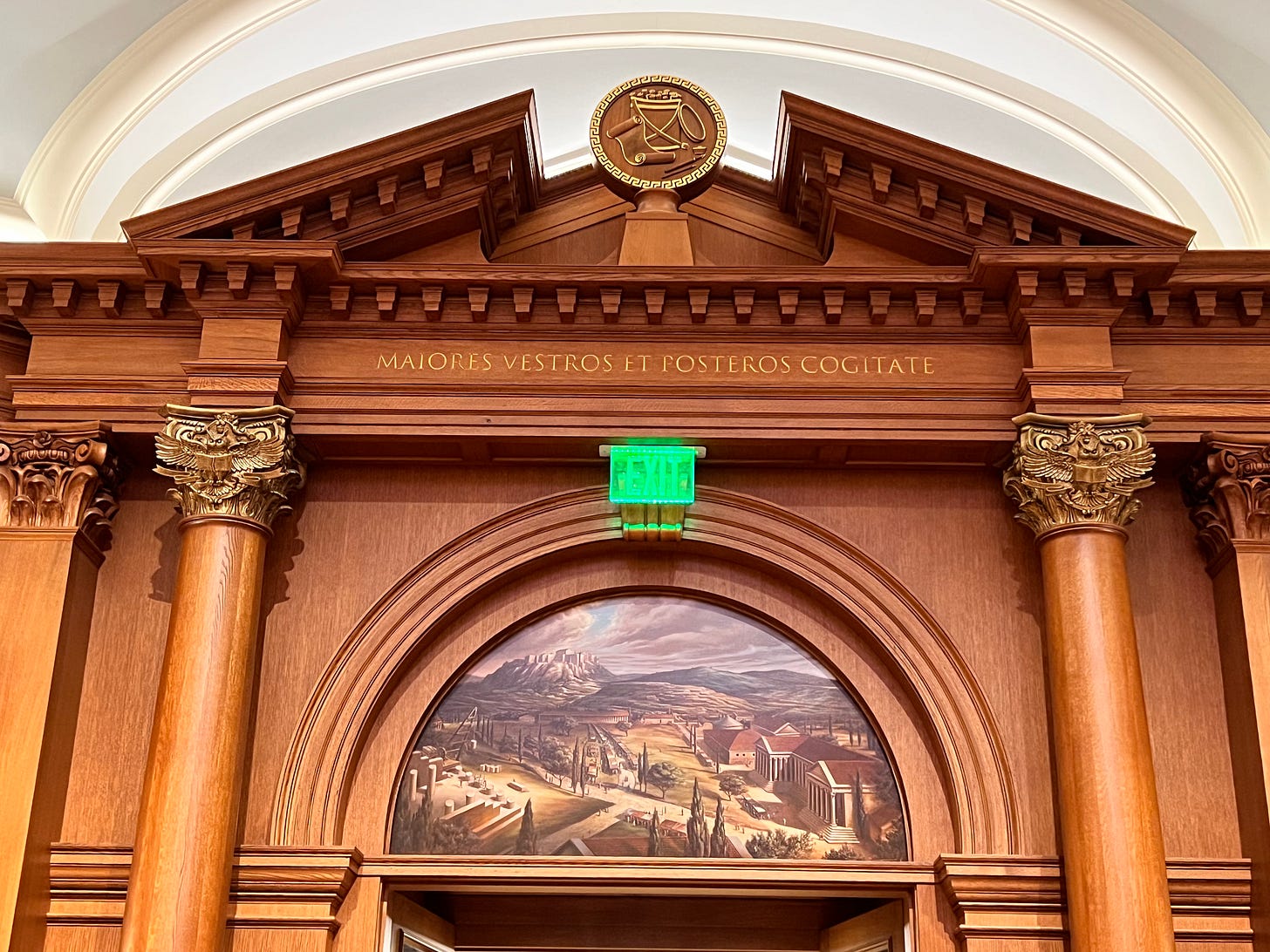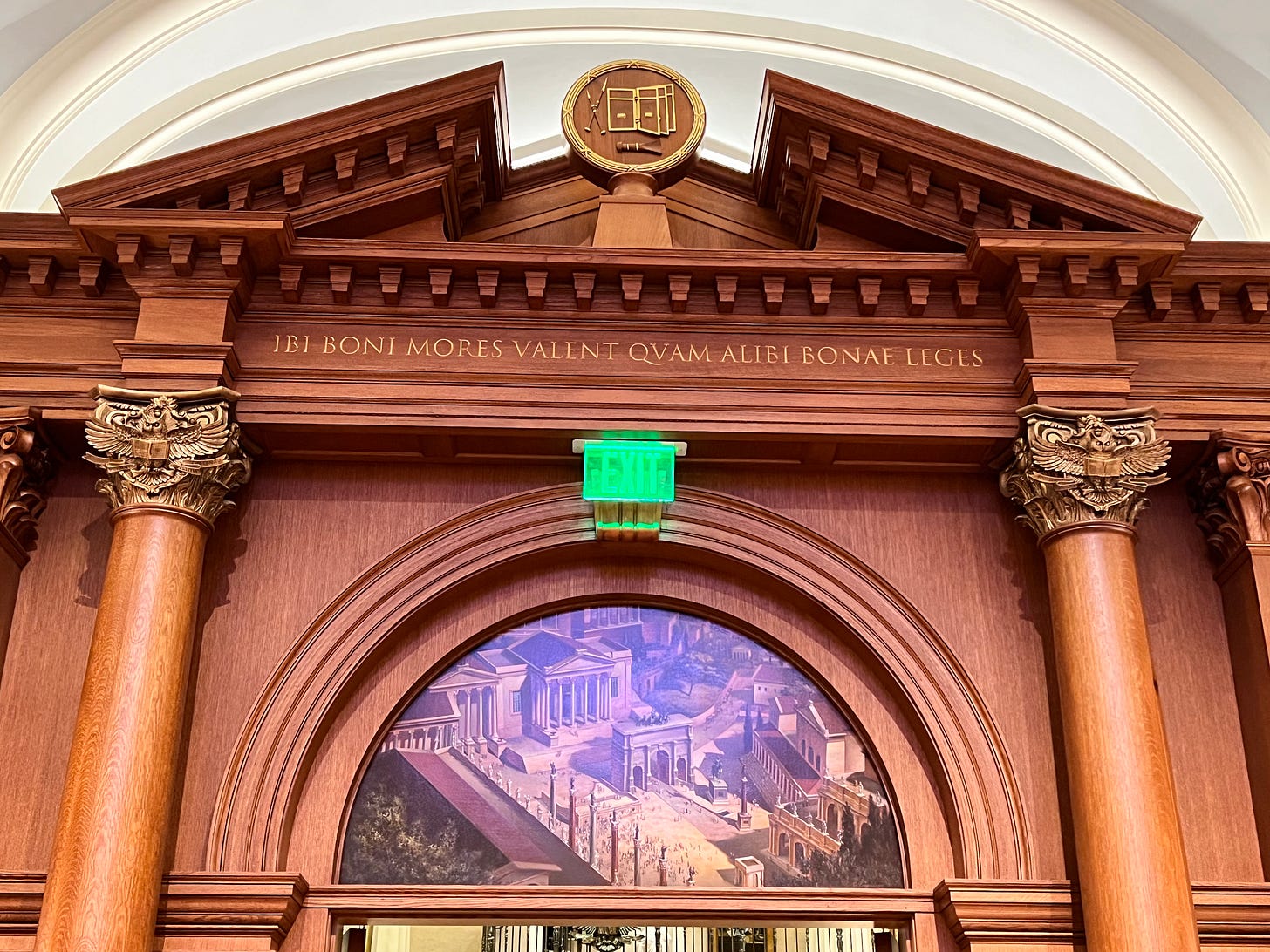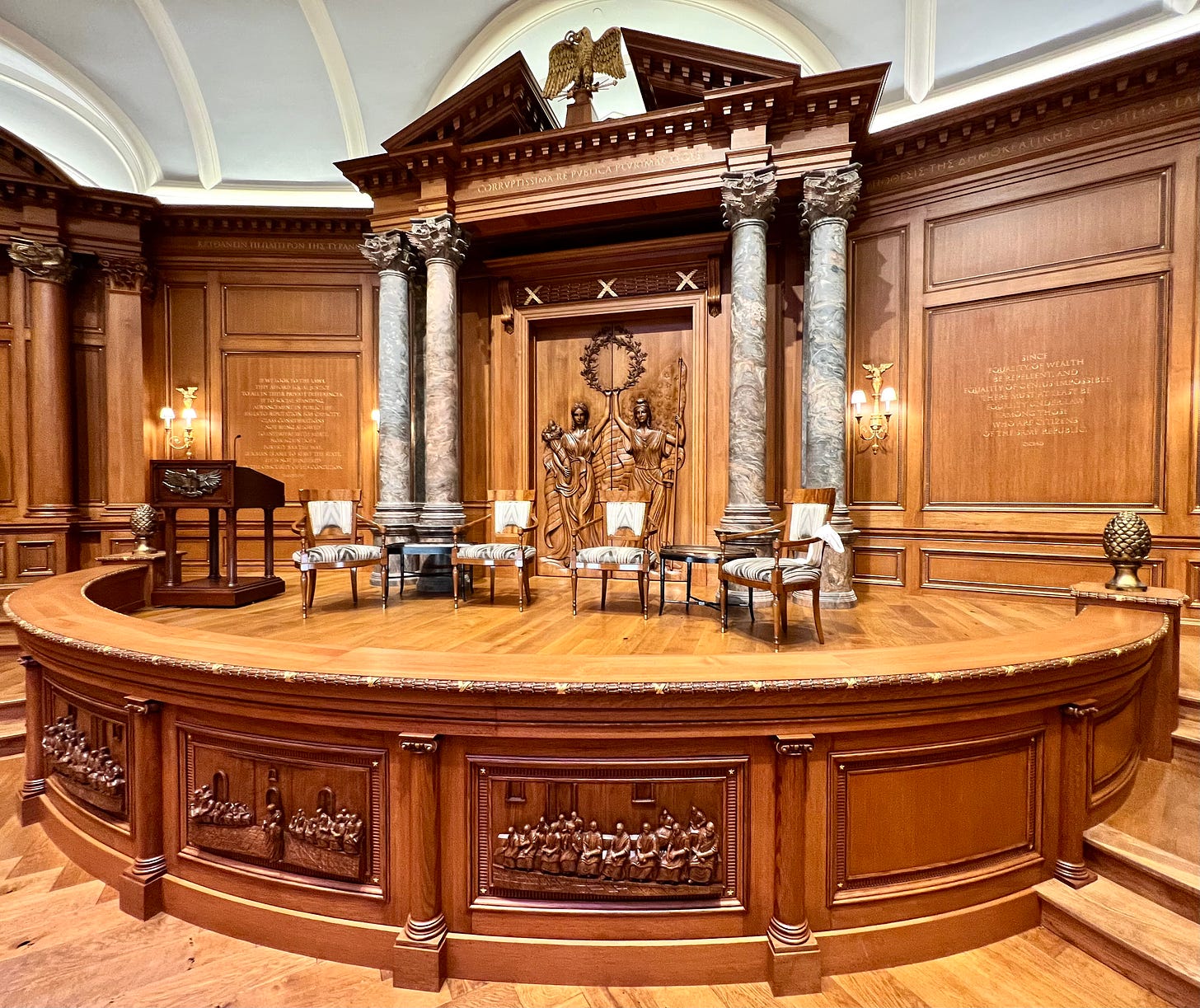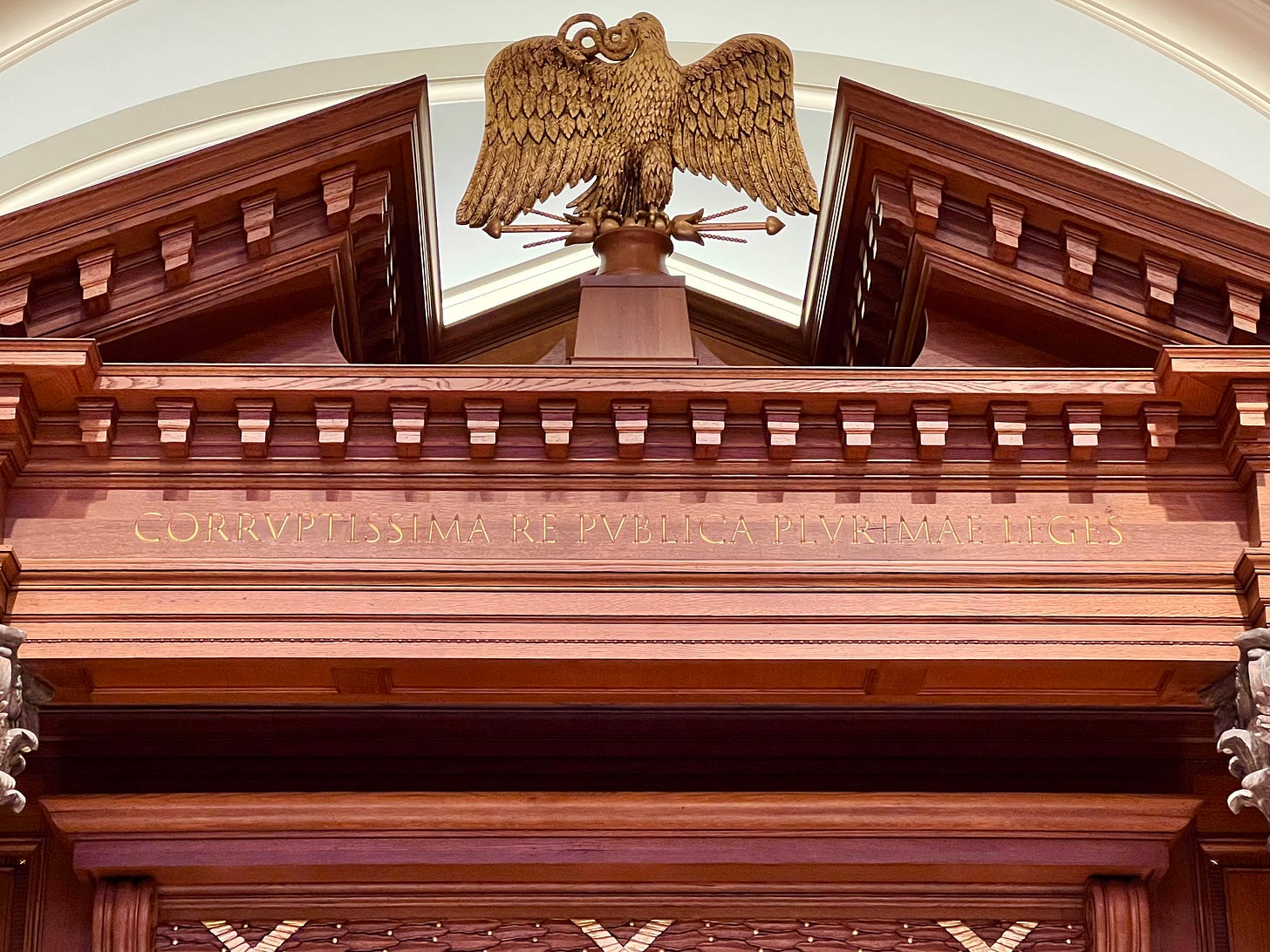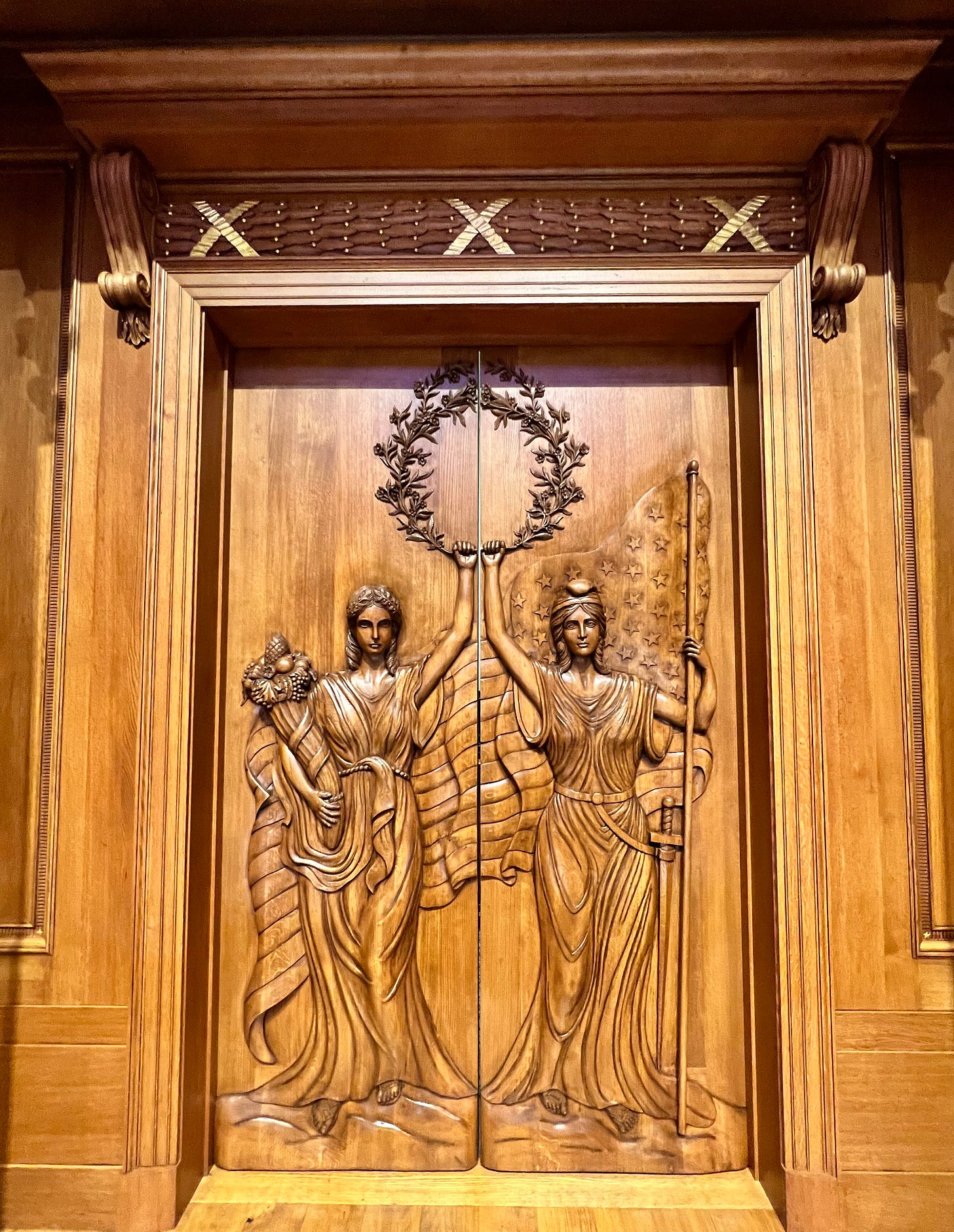The Old Parkland's Debate Chamber: Refreshing Republicanism
The Debate Chamber shows a refined and rare taste for the republican virtues and philosophies which made our nation the great inheritor of Rome.
The Debate Chamber - located two stories underground - is the literal base of the Old Parkland while presenting the intellectual base of the republic in word and form. Here, Roman architecture is given free rein. Greek letters ring the room, and scenes of Athens and Rome frame the doorways. The four virtues stand as solemn guards over the proceedings, and the rostrum proudly displays the Roman Senate in session. It was so rejuvenating. New buildings in the United States are completely devoid of the true inspiration of our form of government. In this age of “Our Democracy,” few seem to remember that we are a republic.
Despite the fact that it is buried, the entire room is filled with light. There is a false skylight that, combined with the size of the room, completely overcomes any sense that one is buried. Further, the lights are set at many different elevations, which greatly reduces the darkness of shadows and imitates the diffuse nature of sunlight.
“If we look to the laws, they afford equal justice to all in their private differences, if to social standing, advancement in public life falls to reputation for capacity, class considerations not being allowed to interfere with merit, nor again does poverty bar the way, man is able to serve the state, he is not hindered if obscurity his condition.” - Thucydides
When one enters, one is struck by the fact that the entire room is made of wood. The wood is very carefully carved and crafted so that it gently slopes to form an oval with many embellishments along the way. There are three entrances, two opposing each other along the narrow curves, and one along one of the broad curves. This entry allows speakers to enter immediately upon the dais.
“Since equality of wealth be repellant and equality of genius impossible, there must at least be equality under the law among those who are citizens of the same republic.” - Cicero
Along the walls, there are some delicate and some bold embellishments. Quotes of great Roman and Greek philosophers and politicians are inlaid in brass. I have spread them throughout the article. The image below is an example of their appearance. All are masculine assertions of the principles which permit a republic to thrive. It was refreshing to see that the ideas that cultivated generations of Americans still find a noble and unapologetic expression somewhere.
“Take heed not to be transformed into Caesar, not to be dipped in the purple dye. Keep yourself therefore, simple, good, pure, grave, unaffected, the friend of justice, religious, kind, affectionate, strong for your proper work, wrestle to be the man philosophy wished to make you.” - Marcus Aurelius
The builder is so opposed to tyranny that he had an ornately framed portrait of the assassination of Julius Caesar hung directly opposite the rostrum. When a speaker looks out over the crowd, there is a quite clear message staring them down: the price of tyranny is death. And the painting is certainly a message. The Debate Chamber has hosted many prominent people. The painting met their gaze each time: a stern reminder.
Government officials are not, of course, powerless. The power of magistrates is hidden above the door through which they enter. The fasces were the instrument of life and death in Rome. They were carried before the consul everywhere he went. When he left the city, they were affixed with an axe. It is this tension, the fasces versus the armed citizenry, that allows liberty to exist between them. It forms a poetic dyad.
“We desire only our liberty, which no honorable man relinquishes but with his life.” - Sallust
To further emphasize the need for a strict moral order, larger-than-life statues of the virtues flanked the doorways. When I was there, only two of the four virtues were present: Prudence and Fortitude. There were two empty alcoves. A speaker, who had previously been to the Debate Chamber, spoke of the “four” statues. The other two virtues would be Justice and Temperance. These speak to the Roman (and American) notion that men who govern themselves need fewer laws to govern them. Personal liberty flows from personal discipline.
“The more corrupt the state, the more numerous the laws.”
Another dyad crosses the room perpendicular to the Caesar-Fasces axis. Above the doors by the which the audience enters the Debate Chamber are two landscapes. These, from what I can tell, are of the Acropolis in Athens and the Capitoline Hill in Rome. These bastions of liberty fortify the doors, protecting the ardent defenders of the republic within the Debate Chamber.

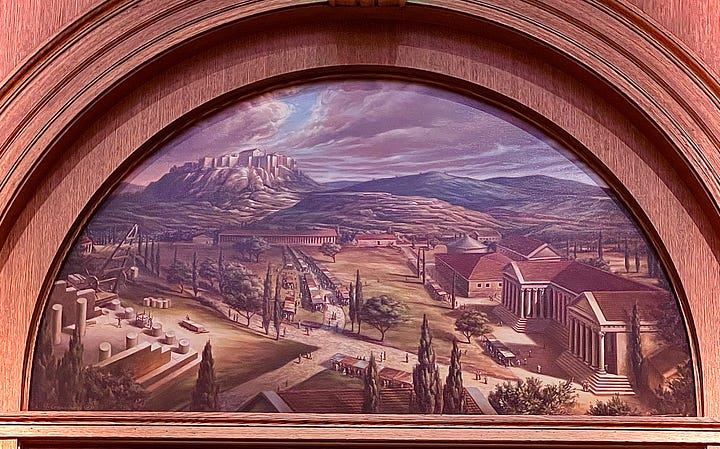
This room also had ingenious methods of integrating traditional styles with modern technology. Two large TVs were hidden in the ceiling’s moulding, capable of dropping down to display remote speakers or presentations for everyone in the room. When not in use, they disappeared into the ceiling without a trace.
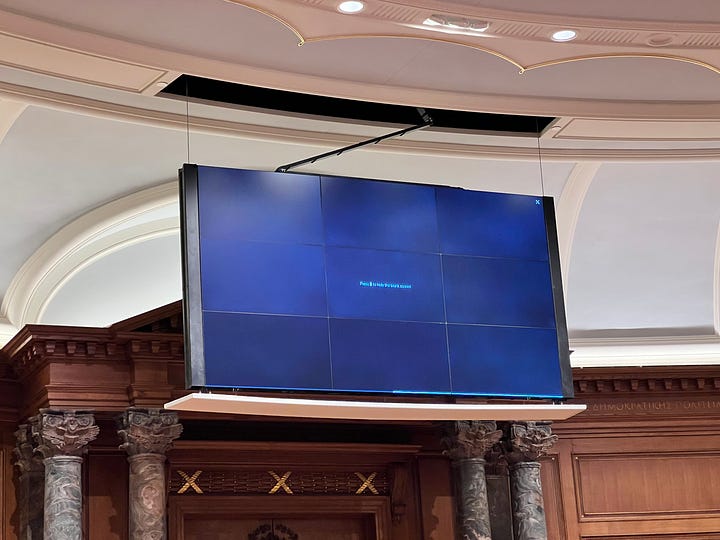
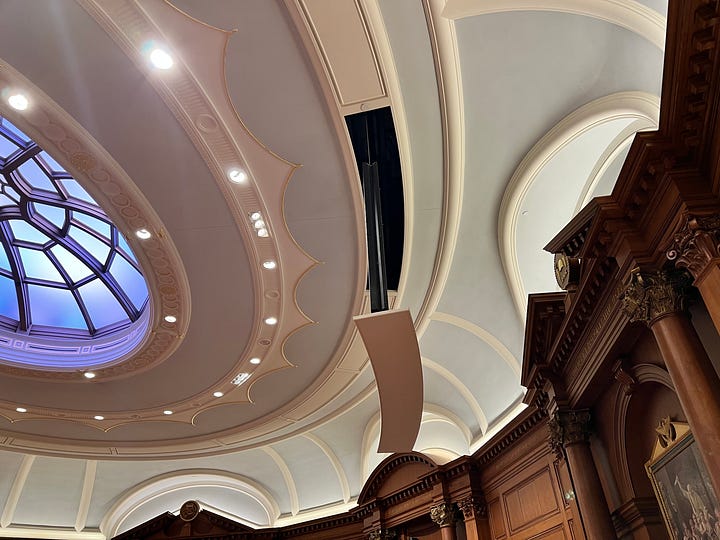
“The tyrant is a child of pride who drinks from his sickening cup recklessness and vanity, until from his high crest headlong he plummets to the dust of hope.” - Sophocles
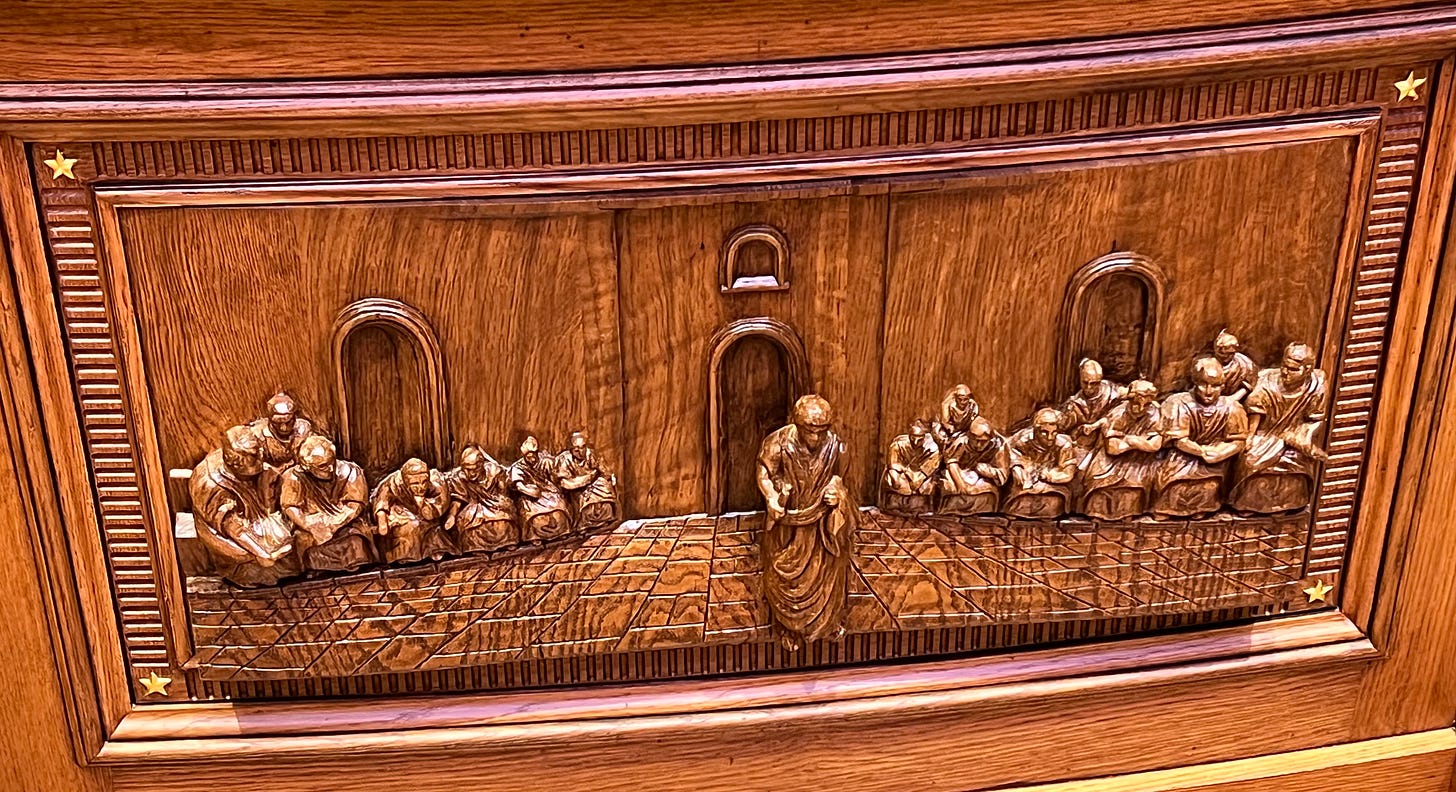
The central focus of the room, however, is the dais. As previously mentioned, its front features a three panel wood carving of the Roman Senate in session. The dais is partially covered by an overhang which resembles the portico of a roman temple. The columns of the portico, notably, are of stone. It is a unique stone that I have never seen before. It is a mixture of green and brown. In most contexts, this would be a rather plain or gross combination of colors, but the fact that the entire room is of a similarly colored wood makes the columns blend quite well with the whole (better in person than in the photos, where the reflection makes them stand out more). The green stands out, while the brown blends in. They are neither an accent piece nor merely the supports for the wood portico. This interpretation is strengthened by the fact that, atop the corinthian-style columns, there is an owl holding a book and ribbon. The ribbon carries the Latin words for the four virtues.
“Such is the nature of the mob: either they are humble and servile or arrogant and domineering. Liberty, the middle course, they know not how to create, or even how to keep.” - Livy
This owl appeared in other places throughout the Old Parkland. I believe it is a sigil for the entire complex. Each building also had a shield, creating a sort of heraldry for the the parts and whole of the complex. I found the owl placed atop the traditional columns to be a delightful touch. It was well executed. I looked at the columns quite a few times in passing before I noticed the owls. It is a testament to the designer, since the shape of the swooping owl accords so well with the corinthian columns.
Atop the portico, there is a brass eagle holding a snake in its beak and arrows in its talons. This is neither the Mexican eagle nor the American eagle, but a sort of cross between the two, perhaps it is neither. If I had to interpret it, I would guess it is an assertion that the majesty of the republic is maintained by strength, and that this strength must be directed against those who would do evil.
“Behold how everywhere luxury destroys flourishing cities. The wrath of the gods does no such harm nor arms nor enemies as thou do, pleasure, sneaking alone into the hearts of men.” - Silius Italicus
The portico bears the inscription “corruptissima re publica plurimae leges,” which means “the more corrupt the state, the more numerous the laws” in Latin. This is an expression of the Founding Father’s conception of liberty, as discussed above. Disciplined people do not need countless laws to inform their conduct. Quite the contrary, a plethora of laws provides a wide opportunity for abuse. Those who write the laws are always in the best place to benefit from them. The best way to limit this abuse is to keep the laws short and sweet.
“This was his character, this stern Cato’s unchanging creed: to keep the golden mean, to hold his purpose, to follow his nature, and to spend his life for his nation.” - Lucan
Beneath the portico, as I mentioned earlier, there are the two women. One bears the American flag, the other holds a cornucopia. Both hold aloft a laurel crown. This is rather plainly an assertion of the triumph of the United States through her plenty and either her republican Constitution or her liberty. The fact that the flag-bearer wears a Phrygian cap—a classical symbol of republicanism—makes her meaning clear. It would not be a stretch to say that the American flag is both the Constitution and liberty, as the Constitution was explicitly written to preserve liberty.
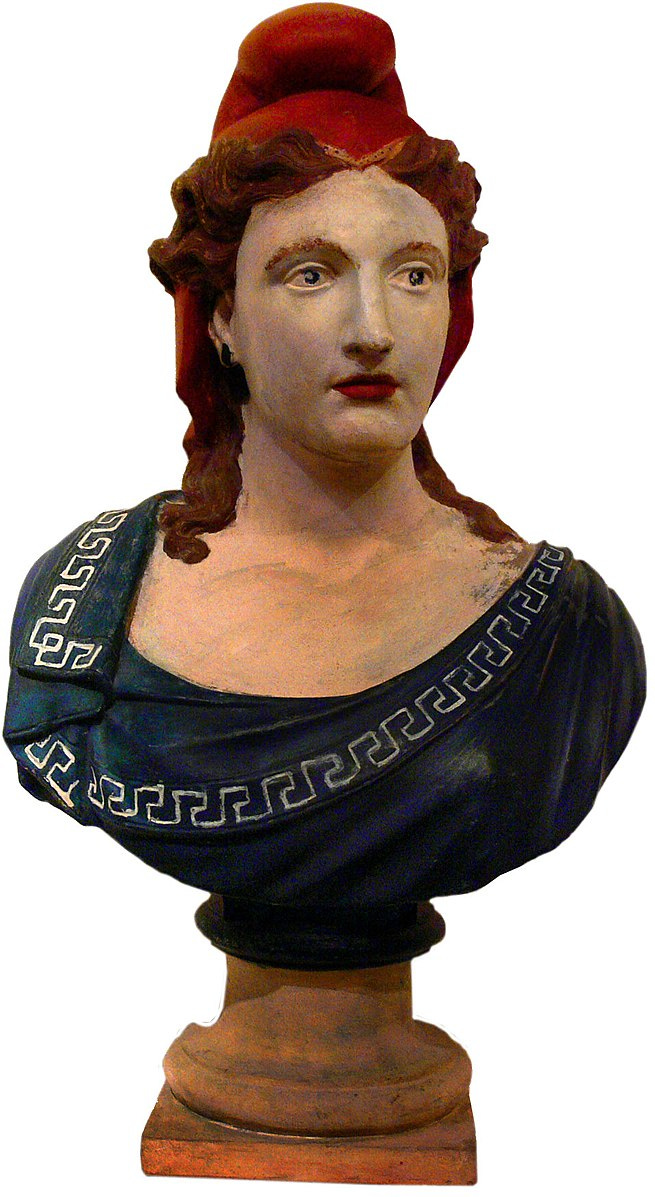
I delighted in being surrounded by the incarnation of the true ideals of the United States. This is a republicanism that is not afraid to face challenges, that seeks to overcome vices. Strength, in this room, is not a tool to bend others to your will, but a means of securing peace so that you may build something beautiful and lasting. Yet peace is clearly not so desired that we should cede ground to preserve it. The room reminds us, in both subtle and forward ways, that action must be taken in moments of crisis, or else all is lost. I so rarely hear such sentiments expressed. Appreciation for art is not a given, nor is peace. Beautiful architecture like this calls on you to be ready to defend your homeland, and gives you something to protect. If art like this is typical of your country, then I say Horace had it right: dulce et decorum est pro patria mori.

